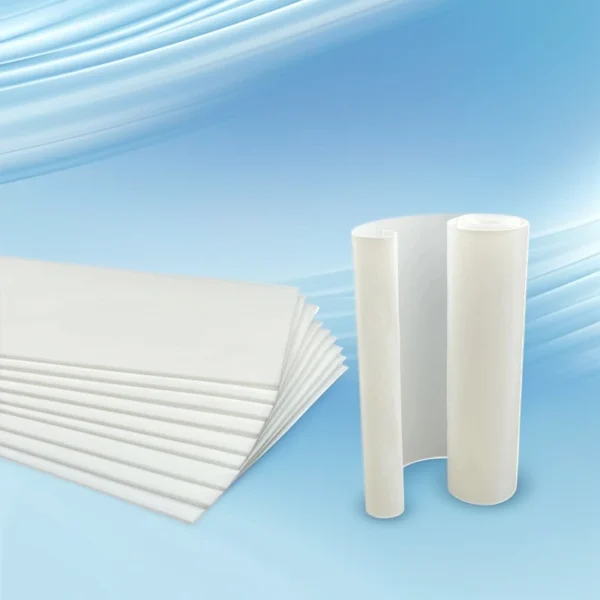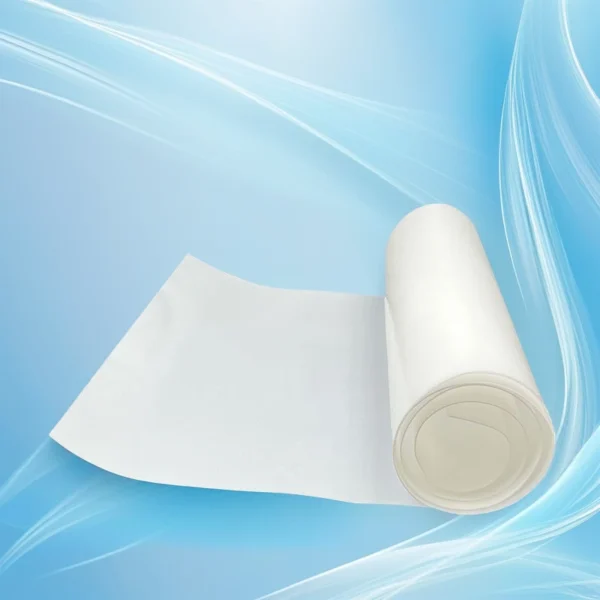Ever wondered how that super-slippery, heat-resistant PTFE film is made?
I get it.
You’re probably thinking about:
- How to ensure consistent quality in PTFE film production.
- What technology is used in the PTFE manufacturing process?
- Where to find reliable information on PTFE quality standards.
- How to choose the right ptfe sheeting for your application.
- The difference between different PTFE film types, like ptfe skived film.
Let’s break it down, step-by-step.
What is PTFE Film?
PTFE (Polytetrafluoroethylene), often known as Teflon™, is a synthetic fluoropolymer.
It boasts exceptional properties, including:
- High chemical resistance
- Excellent thermal stability
- Outstanding dielectric properties
- Low coefficient of friction
These characteristics make it ideal for various applications, from aerospace and electronics to medical devices and food processing.
High-Temperature Resistant PTFE Skived Film for Industrial Seals & Gaskets
PTFE Skived Film offers exceptional chemical stability and thermal resistance (-200°C to +260°C), ideal for industrial seals in pumps, valves, and chemical processing equipment[4]. Its low friction coefficient (0.04) ensures durability in dynamic applications, while the microporous structure (85% porosity) provides liquid and particle resistance.
Applications: Corrosion-resistant gaskets, aerospace engine coatings, and medical-grade filtration membranes.
Understanding the PTFE Manufacturing Process
The PTFE manufacturing process is complex. Different techniques influence the final product’s properties.
Here’s a simplified overview:
- Raw Material Preparation: PTFE resin is received in powder or granular form.
- Molding/Preforming: The resin is compressed into a desired shape (billets or preforms).
- Sintering: The preform is heated to a high temperature (typically 360-380°C) to fuse the PTFE particles together. This process enhances its mechanical strength and thermal stability.
- Skiving/Extrusion/Coating: This is where the magic happens, creating the film.
- Quality Control: Rigorous checks ensure the film meets specific standards.
PTFE Skived Film Production: The Details
PTFE skived film is created by shaving a thin layer from a cylindrical PTFE billet.
Think of it like using a vegetable peeler on a giant carrot.
This method provides excellent uniformity and tight tolerances.
Here’s the skiving process, step-by-step:
- Billet Preparation: A cylindrical PTFE billet is prepared through molding and sintering.
- Skiving: The billet rotates while a blade precisely shaves off a continuous film.
- Winding: The skived film is wound onto a roll.
- Inspection: The film is inspected for defects and to ensure it meets thickness requirements.
Why is skiving so popular?
- Excellent Thickness Control: Skiving provides very uniform film thickness.
- High Purity: The process minimizes contamination.
- Versatility: Skiving can produce a wide range of thicknesses.
Alternative PTFE Film Production Methods
While skiving is prevalent, other methods exist:
- Extrusion: PTFE paste is forced through a die to create a continuous film.
- Coating: PTFE dispersion is coated onto a substrate and then dried and sintered.
Each method has its advantages and disadvantages, influencing the film’s properties and suitability for specific applications.
Technology Used in PTFE Film Manufacturing
The PTFE manufacturing process relies on sophisticated equipment and techniques:
- Precision Molding Machines: Ensure accurate preform dimensions.
- Controlled Sintering Furnaces: Maintain precise temperature control for optimal fusion.
- High-Precision Skiving Machines: Guarantee uniform film thickness.
- Automated Inspection Systems: Detect defects and ensure quality.
Advanced technologies are continuously being developed to improve efficiency and enhance film properties. For example, some manufacturers use plasma treatment to enhance the surface properties of PTFE films.
PTFE Quality Standards: Ensuring Reliability
PTFE quality standards are crucial for ensuring that the film meets the required performance characteristics.
Key standards include:
| Standard | Description |
|---|---|
| ASTM D3308 | Standard Specification for PTFE Resin Molded Basic Shapes |
| ASTM D1457 | Standard Specification for PTFE Molding and Extrusion Materials |
| MIL-PRF-22191 | Military Specification for PTFE Film |
| ISO 9001 | Quality Management System |
| RoHS Compliance | Restriction of Hazardous Substances |
| REACH Compliance | Registration, Evaluation, Authorisation and Restriction of Chemicals |
These standards cover various aspects, including:
- Tensile Strength: The ability of the film to withstand pulling forces.
- Elongation: The amount the film can stretch before breaking.
- Dielectric Strength: The film’s ability to resist electrical breakdown.
- Thickness Tolerance: The acceptable variation in film thickness.
- Surface Finish: The smoothness and uniformity of the film surface.
Third-party certifications like ISO 9001 demonstrate a manufacturer’s commitment to quality.
Choosing the Right PTFE Sheeting
Selecting the appropriate ptfe sheeting depends on the application’s specific requirements.
Consider these factors:
- Thickness: Thicker films offer greater strength and durability.
- Surface Finish: Smooth surfaces are crucial for applications requiring low friction.
- Operating Temperature: Ensure the film can withstand the operating temperature range.
- Chemical Resistance: Verify the film is resistant to the chemicals it will be exposed to.
- Electrical Properties: Choose a film with the appropriate dielectric strength for electrical applications.
Pro Tip: Consult with a PTFE film manufacturer or supplier to determine the best film for your needs.
Real-World Applications
PTFE film is used in a wide array of industries:
- Electronics: Insulation for wires and cables, capacitor films.
- Aerospace: Sealants, gaskets, and insulation for aircraft components.
- Medical: Implantable devices, surgical drapes.
- Automotive: Seals, gaskets, and bearings.
- Food Processing: Non-stick surfaces for cookware and equipment.
Common Problems and Solutions
Even with advanced technology, issues can arise during the PTFE film production process.
Here are some common problems and their solutions:
- Problem: Non-uniform thickness.
- Solution: Optimize skiving parameters, improve billet preparation.
- Problem: Surface defects (scratches, pinholes).
- Solution: Improve handling procedures, use cleaner environments.
- Problem: Poor tensile strength.
- Solution: Optimize sintering parameters, use higher-quality resin.
The Future of PTFE Film Manufacturing
The PTFE manufacturing process is constantly evolving.
Emerging trends include:
- Nanotechnology: Incorporating nanoparticles to enhance film properties.
- 3D Printing: Creating complex PTFE film structures.
- Sustainable Manufacturing: Developing more environmentally friendly production methods.
According to a report by Grand View Research, the global PTFE market is expected to reach \$5.5 billion by 2028, driven by increasing demand in various industries. This growth will likely spur further innovation in PTFE film manufacturing technologies.
Medical-Grade Skived PTFE Film for Sterile Filtration & Implant Coatings
Medical-grade Skived PTFE Film combines biocompatibility and microporous filtration (0.02–15 μm pore size), meeting stringent pharmaceutical standards. The non-toxic material is used in drug delivery systems and implant coatings, ensuring chemical inertness and thermal stability under sterilization.
Key Features: UV-resistant, FDA-compliant, and adaptable to rapid thermal cycling.
FAQs About PTFE Film
What is the difference between PTFE film and PTFE tape?
PTFE film is typically thinner and more uniform than PTFE tape. Tape often has an adhesive backing.
Is PTFE film recyclable?
PTFE is not easily recyclable due to its chemical inertness and high processing temperatures. However, some companies are exploring innovative recycling methods.
How do I store PTFE film?
Store PTFE film in a clean, dry environment away from direct sunlight and extreme temperatures.
Is PTFE film safe for food contact?
Yes, PTFE film that meets FDA regulations is safe for food contact applications.
How to Identify High-Quality PTFE Film?
Look for certifications like ISO 9001, consistent thickness, and a smooth surface finish. Request a material data sheet from the manufacturer for detailed specifications.
Conclusion: Mastering the PTFE Film Manufacturing Process
The PTFE film manufacturing process is a blend of science, technology, and rigorous quality control.
Understanding the nuances of skiving, extrusion, and other production methods is crucial for selecting the right film for your application.
Chemical-Resistant Skived PTFE Film for Electronics & High-Frequency Cables
Skived PTFE Film provides stable dielectric performance in high-frequency and high-voltage electronics. With resistance to acids, alkalis, and solvents, it ensures reliability in circuit boards, cables, and semiconductor manufacturing.
Key Features: Non-aging, tensile strength exceeding steel wire, and compliance with SAE AMS3661D standards.





